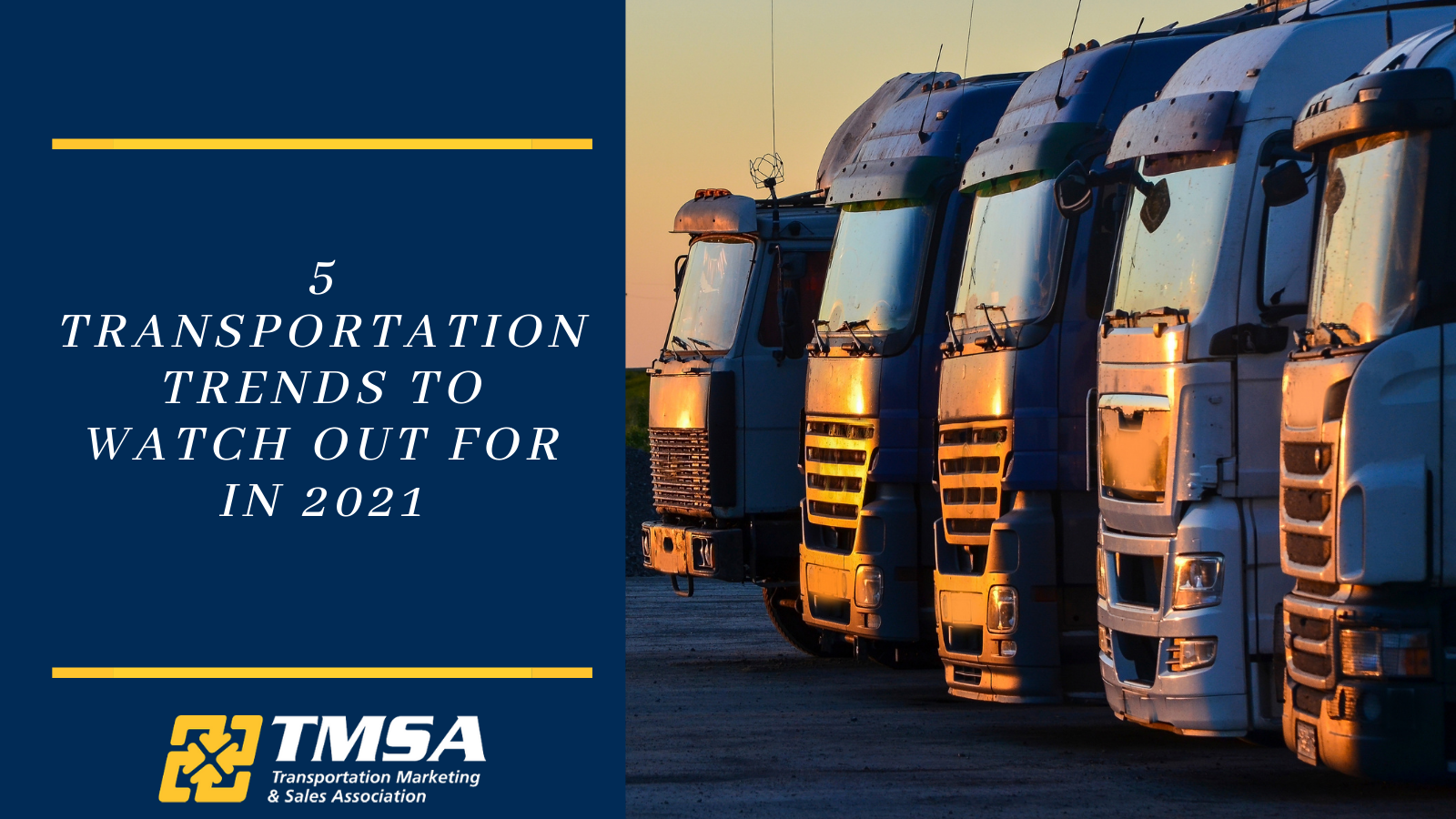
Written By: Conrad Winter | Mar 25, 2021 12:00:00 AM
It’s no surprise that technology is the major driver of industry transformation today. Its many manifestations from driverless trucks to AI keep it firmly at the top of oncoming transportation trends. However, demographic swings and lasting changes in consumer preferences will also determine the opportunities and challenges on the road ahead.
Holly LaBoda, partner and co-founder of Luminaries Consulting, laid out the top five  trends in transportation during TMSA’s recent Transportation 101 webinar. Knowing them, understanding them and preparing for them is a must for shippers and transportation providers alike.
trends in transportation during TMSA’s recent Transportation 101 webinar. Knowing them, understanding them and preparing for them is a must for shippers and transportation providers alike.
Are you interested in watching the Transportation 101 webinar? All previous webinars are available on-demand for TMSA members. Contact TMSA today to become a member!
Cloud, AI and big data are allowing companies to do things like automated route planning and optimization. “It’s helping companies figure out how to make the best use of their trucks in the complicated infrastructure in our country,” LaBoda said.
It’s also enabling transportation and logistics managers to do sophisticated bid management.
“Think about your sales data layered on top of Freightwaves’ market information,” she mused.
When companies start adding in predictive analytics, she said the results will be even more powerful.
The second major trend happening right now is electronic and autonomous trucks and vehicles. Autonomous vehicles are already in use in some ports and yards where the routes can be tightly managed. According to LaBoda, the opportunities of autonomous technology are far-reaching when combined with sensors and other technologies. “It’s not just about the electrification of commercial vehicles — or these big, man-less trucks — it’s also all these different components that make things autonomous or semi-autonomous,” she said.
There will be huge potential for savings in transportation costs, but this benefit will come at a huge expense. The fueling infrastructure will need to change and the maintenance of electric vehicles is different.
“It’s more than just flipping a switch,” she said.
Right now there are 3.5 million drivers in the U.S. according to the U.S. Census Bureau. LaBoda said that over the next decade, the industry will be challenged to hire 1.1 million drivers — 110,000 per year — to make up for the expected shortfall caused by aging and retiring drivers.
The reality is the average age of over the road drivers today is 46, There aren’t enough younger drivers to fill their seats as they age-out. LaBoda believes the reason is lifestyle related. Entry level opportunities are often for long-haul jobs that can require days away from home, which makes them a hard sell for young people.
There is opportunity in hiring female drivers who are currently underrepresented in the industry. Although women make up nearly half the U.S. workforce, only 6.6% of truck drivers are female.
Dashcams, GPS and telemetric sensors are already being used widely today to monitor and correct driver performance in order to promote safety, compliance and efficiency.
Tracking technologies like these are providing powerful insights and being leveraged to optimize fuel usage and schedule maintenance. The data is being used to correct behavior in the moment, after the fact, and increasingly, in the future. According to Laboda, it’s even being used to do things like predict who might get into an accident.
The fifth major trend concerns the confluence of automation, developments in global trade, omnichannel and blockchain. According to LaBoda, “All of this is about the ability to see the complete history of goods and services in the supply chain and gain visibility into where things are now and be able to flex multiple modes to get things delivered to where they need to be most efficiently and cost effectively.”
Visibility is a hot button in transportation and currently getting a lot of investment and innovation and intellectual effort globally, she says. It’s important because the goal of a transportation management system (TMS) or a warehouse management system (WMS) is fundamentally to help users figure out where goods are in the supply chain in real time. The knowledge is power to transportation professionals and customers alike because it enables them to coordinate resources and plan more effectively.
Blockchain is helping to drive the next level of supply chain visibility. LaBoda described it as “a shared global database that enables microstatuses of where things are at any given moment.”
There is tremendous opportunity using blockchain to accurately trace food shipments globally from origin to destination. By being able to see every part of the process, issues in the supply chain can be easily identified and fixed.
Omnichannel anticipates the need to try and figure out how to deliver goods through various different modes and services and ways that things can go to market. Buy online pickup in store (BOPIS) is an example of this. It’s omnichannel because two different channels work together. Increasingly, transportation and logistics providers are being called upon to adapt to the new and different ways consumers want to buy and that products can go to market.
The mandate to respond to how consumers are buying things — and increasingly, how businesses are buying things — is driving investment in automation. LaBoda credits Amazon for changing expectations of buyers on both sides. Warehouses are automating storage, planning, picking and packing, all to allow 1- or 2-day delivery and meet buyers’ unrelenting expectations of complete transparency and tracking during shipping, no hassle returns and direct anywhere service.
Although transportation is a big and established industry, it’s changing all the time. LaBoda stresses that “It’s important to keep track of all these things because your customers expect you to give them advice based on how the industry is changing and expect your business to adapt.”
If you are a TMSA member, you can get the full details of these five trends by watching TMSA’s recent Transportation 101 webinar, featuring experts from cold chain, port management and more. Not yet a member? Stay on the cusp of transportation sales & marketing trends by joining us today! Learn more here.
Tags:
Feb 07 As we enter February 2022, peak season is far behind us, but high freight demand and supply chain crises haven’t magically disappeared as some had hoped. Truck driver recruitment and retention...
Feb 14 More than one-in-three American labor force participants (35%) are Millennials, making them the largest generation in the U.S. labor force, according to a Pew Research Center analysis of U.S....

As with any successful business, companies in transportation and logistics continue to look at ways to effectively communicate with and engage their workforces. With 45% of TMSA members directly...